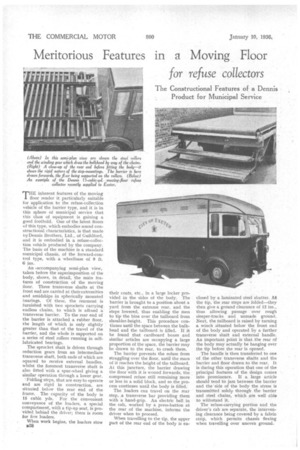Meritorious Features in a Moving Floor for refuse collectors
Page 56

If you've noticed an error in this article please click here to report it so we can fix it.
The Constructional Features of a Dennis Product for Municipal Service THE inherent features of the moving floor render it particularly suitable for application to the refuse-collection vehicle of the barrier type, and it is in this sphere of municipal service that this class of equipment is gaining a good foothold. One of the latest floors of this type, which embodies sound constructional characteristics, is that made byDennis Brothers, Ltd., of Guildford, and it is embodied in a refuse-collection vehicle produced by the company. The basis of the machine is a standard municipal chassis, of the forward-control type, with a wheelbase of 9 ft. 6 ins.
An '.accompanying semi-plan view, taken before the superimposition of the body, shows, in detail, the main features of construction of the moving floor. Three transverse shafts at the front end are carried at their extremities and amidships in spherically mounted bearings. Of these, the rearmost is furnished with two sprockets carrying endless chains, to which is affixed a transverse barrier. To the rear end of the barrier is attached a rubber floor, the length of which is only slightly greater than that of the travel of the barrier, and the whole is supported on a series of steel rollers running in selflubricated bearings.
The sprocket shaft is driven through reduction gears from an intermediate transverse shaft, both ends of which are squared to receive external handles, whilst the foremost transverse shaft is also fitted with a spur-wheel giving a similar operation through a lower gear. 'Folding steps, that are easy to operate and are rigid in construction, are situated below the rear end of the frame. The capacity of the body is 15 cubic yds. For the convenient conveyance of the loaders, a special compartment, with a tip-up seat, is provided behind the driver; there is room for five loaders.
When work begins, the loaders stow B38 their coats, etc., in a large locker provided in the sides of the body. The barrier is brought to a position about a yard from the extreme rear, and the steps lowered, thus enabling the men to tip the bins over the tailboard from shoulder-height. This procedure continues until the space between the bulkhead and the tailboard is filled. If it be found that cardboard boxes and similar articles are occupying a large proportion of the space, the barrier may be drawn to the rear, to crush them.
The barrier prevents the refuse from straggling over the floor, until the mass of it reaches the height of the tailboard. At this juncture, the barrier drawing the floor with it is wound forwards, the compressed refuse still remaining more or less in a solid block, and so the process continues until the body is filled.
The loaders can travel on the rear step, a transverse bar providing them with a hand-grip. An electric bell in the cab, worked by a press-button at the rear of the machine, informs the driver when to proceed.
When travelling to the tip, the upper part of the rear end of the body is en closed by a laminated steel shutter. At the tip, the rear steps are folded—they then give a ground clearance of 12 ins., thus allowing passage over rough sleeper-tracks and unmade ground. Next, the tailboard is raised by turning a winch situated below the front end of the body and operated by a further transverse shaft and external handle. An important point is that the rear of the body may actually be hanging over the tip before the rear is opened.
The handle is then transferred to one of the other transverse shafts and the barrier and floor drawn to the rear. It is during this operation that one of the principal features of the design comes into prominence. If a large article should tend to jam between the barrier and the 'side of the body the stress is transmitted solely through the barrier and steel chains, which are well able to withstand it.
The refuse-carrying portion and the driver's cab are separate, the intervening clearance being covered by a fabric strip, which permits chassis flexing when travelling over uneven ground.




































































































